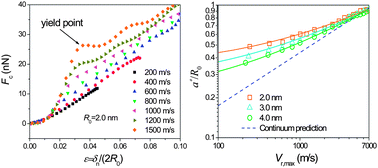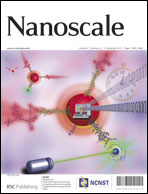The dynamic effect on mechanical contacts between nanoparticles†
Abstract
The rich behaviors of high-speed mechanical contacts at the nanoscale have been studied. The seldom observed elastic–plastic transition governed by Hertz and Thornton models has been clearly unveiled, the origins of the hardening effect and the deformation mechanism of nanoscale plasticity have been discussed in terms of structural changes after compression and a series of physical quantities are measured including contact forces, contact radius, contact stress, coefficient of restitution and total impact time. Our simulation results closely resemble experiments and/or theoretical predictions: (i) when impact speed v is higher than Y/ρc0, the elastic–plastic deformation transition occurs, (ii) the yielded apparent elastic modulus and hardness are larger than those of the bulk, (iii) the initiating yield stress Y and hardness P0 still satisfy P0 ≈ 1.6Y, (iv) particle's volume decreases during compression, (v) contact radius a follows a ∝ v2/5, (vi) at v ≥ 2000 m s−1, the coefficient of restitution follows e ∝ v−1/4 and (vii) the total time of impact follows Tc ∝ v−1/5. However, there also exist many quantitative differences. The contact radius and final contact radius are underestimated by the continuum predictions while the total impact time is overestimated, but all of them reasonably agree with theoretical predictions with an increase of contact area and impact speed. The theoretical equation is adapted to predict the final contact radius during normal impact, in which the contact radius at zero load is also formulated.


 Please wait while we load your content...
Please wait while we load your content...